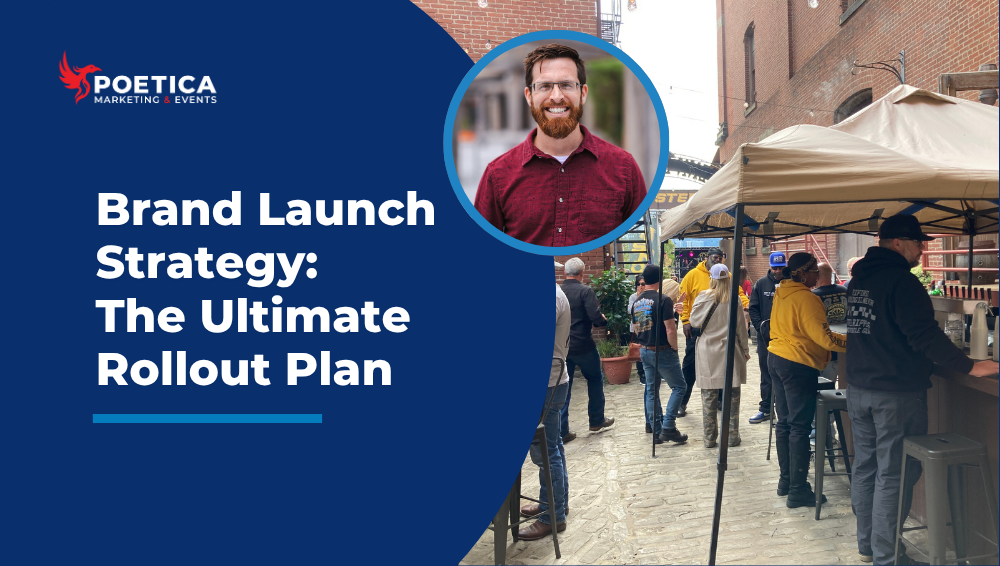Starting a new company is a bold endeavor. You’re putting your vision, resilience, and ideas to the test—to see if you have what it takes to build a sustainable business model designed for long-term growth. And that’s why a brand launch strategy is so important.
Without a smart, comprehensive brand launch plan, your great idea will remain a great idea—without anyone else knowing about it.
But with the right strategy in place, you can market your brand to your ideal target audience and make a major splash at the same time, building a foundation for your growth in the years to come.
Remember: There’s no “easy” button when it comes to branding. After all, if you have a company, you have a brand. Here’s how our Lead Designer Nicole Suchin puts it:
“Every business has a brand, whether they realize it or not, and regardless of whether they’ve invested any time into it. That said, not every business has one that is truly working to their advantage.”
– Nicole Suchin, Poetica Marketing Lead Designer
Use our table of contents to learn more!
TL;DR: What Is A Good Brand Launch Strategy?
A brand launch strategy is a step-by-step plan for introducing your brand to the market in a way that builds awareness, generates interest, and drives early traction. A successful brand launch plan includes understanding your audience, refining your brand identity, creating consistent messaging, involving key partners and ambassadors, and coordinating a go-to-market timeline across digital, print, and in-person platforms.
Table of Contents
What Is A Brand Launch?
Why Is A Good Brand Launch Strategy So Important?
How to Coordinate A Successful Brand Launch Strategy
Brand Launch Strategy Case Study: Steel Rippers
Find Your Brand Strategy Partner
Frequently Asked Questions About Brand Launch Strategy
What Is A Brand Launch?
A brand launch is the exciting moment when your company officially opens to the public, both online and in person. With the right momentum behind it, a brand launch can boost early sales, create invaluable PR for your organization, and build a lasting community around your business.
In the worst cases, a “brand launch” is little more than a Facebook post that says, “We’re so excited to announce that we’re officially open for business!”
But in the best-case scenarios (which often result in the strongest impact for the business), a brand launch is a multi-prong strategy that announces your company’s presence to the proper target audience and compels them to take action.
This strategy should focus on not just trying to catch the eyes of your audience, but also to form a genuine connection with them. The reason we claim a small Facebook post to be the worst case is because it feels impersonal. For a brand launch to be truly successful, it needs to emotionally resonate.
“Branding is the relationship that your audience has with your business. It’s the emotional and psychological reactions that they’re having when they engage with pieces of your business… And I would say brand strategy is the foundation of all other business strategies, including marketing, design, advertising, and more.”
– Nicole suchin, poetica marketing lead designer
Why Is A Good Brand Launch Strategy So Important?
For many of the business owners we talk to, branding and marketing are afterthoughts in their overall business plan.
On one hand, it makes sense: Branding and marketing seem secondary to the actual delivery of outstanding products and services.
But everything about your business goes hand-in-hand. If your branding and marketing are subpar, you’ll suffer from:
- Damaged reputation, which could harm your overall leads, sales, and revenue.
- Reduced customer experience, which may negatively affect repeat business.
- Limited opportunities from investors, should you ever decide to sell your business.
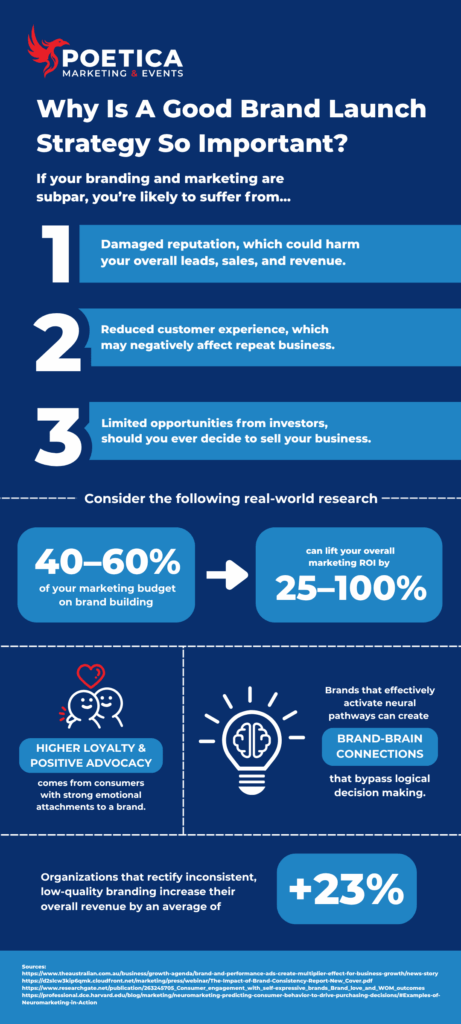
These aren’t general observations; they’re backed up by real-world research. Consider the following:
- Branding emphasis drives revenue: One study from the World Advertising Research Centre found investing 40–60% of your marketing budget on brand building can lift your overall marketing ROI by 25–100%. That’s huge!
- Consistency creates value: Organizations that rectify inconsistent, low-quality branding increase their overall revenue by an average of 23%, according to a study by Demand Metric and Lucidpress.
- People form relational attachments to brands: Studies show consumers with strong emotional attachments to a brand exhibit higher loyalty and positive advocacy (meaning they enthusiastically spread your brand by word-of-mouth). They could even experience “separation distress” if they feel distanced by your brand.
- Consumers’ brain chemistry is affected by positive and emotive brand experiences. Consumer neuroscience research reveals brands that effectively activate neural pathways can create brand-brain connections that bypass purely logical decision-making—meaning they may be more willing to buy your products and services even when your competitors have superior offers.
That’s powerful research. Obviously, solid branding isn’t just about pretty aesthetics. It’s about your company’s financial (and social) wellness.
That leads us to an important question:
How do you coordinate a successful brand strategy?
Well…
How to Coordinate A Successful Brand Launch Strategy: 6 Steps
The most successful brands don’t leave anything to chance. Here’s how to coordinate an effective launch in six steps:
1. Understand Your User
Before you create your logo or write your tagline, you need to know exactly who you’re trying to reach.
Too many businesses skip this step—and it shows. They make branding decisions based on their personal preferences or trends, instead of customer insights.
Consider the recent (disastrous) Cracker Barrel rebrand, which resulted in severe public backlash and countless thoughtpieces on what a terrible idea it was.
The Cracker Barrel team fell for the “clean and modern” trend of design without understanding their audience. But branding isn’t about you, and it’s not about appealing to everybody either. It’s about the specific people you’re trying to serve.
Ask yourself:
- What are your users’ pain points?
- What motivates their buying decisions?
- Where do they spend time online—and offline?
- What do they need to see, hear, or feel to trust you?
Once you’ve answered these questions, your brand becomes a strategic tool that speaks directly to your audience’s needs, rather than a visual playground that simply reflects your favorite color.
Getting back to the Cracker Barrel snafu: A major reason why that campaign failed was because the redesign didn’t align with the persona it had spent so many years creating—and that its fans had become emotionally attached to. (Remember when we said a brand can create emotional attachments?)
Related Reading: All Marketing Is Human-to-Human Marketing (Regardless of Your Industry)
2. Understand Your Product or Service
You’d be surprised how many brand launches struggle simply because the founder hasn’t clearly defined what they’re offering.
Sure, you might “know” your product or service—but can you explain it clearly and concisely to a stranger who’s never heard of you before?
More importantly: Can your audience understand the value of what you’re offering within a few seconds?
Clarify:
- What makes your product or service different?
- What specific problems does it solve?
- Why is now the right time for it to exist?
Remember: You’re not just launching a brand—you’re launching a solution. The more clearly you articulate your offering, the easier it becomes to market.
Poetica Marketing Pro Tip: Many new founders are encouraged to follow the “Hedgehog Concept” in Good to Great—the seminal business book outlining what makes high-powered brands. While the Hedgehog Concept is excellent in encouraging you to think in terms of…
- What can you be the best at?
- What are you passionate about?
- What can you make money doing?
…it doesn’t go quite far enough. The Japanese concept of ikigai adds a critical fourth layer to the equation:
- What does the world need?
That is a powerful starting point for building your business and your branding!
3. Understand Your Brand
This might seem obvious, but you’d be surprised at how many new businesses rush through their branding—often resulting in inconsistent visuals, unclear messaging, and a disconnect between who they are and how they’re perceived.
These days, it’s all too easy to inject an AI logo, or pick from a list of “pre-made” branding, and prioritize convenience over intentionality. While those options make it easier on the business owner, they immediately cheapen your brand.
Think of it like entering a crowded room where you’re wearing the same outfit as everyone else. Your brand will end up blending in rather than standing out.
To avoid this, take the time to answer foundational questions:
- What do you want to be known for?
- What values drive your company forward?
- What kind of feeling should your brand evoke?
Once you’ve nailed your identity, you can craft consistent messaging, visuals, and experiences that reinforce your brand at every touchpoint. In other words: Your branding stops being a “logo” and starts becoming a reputation.
For additional guidance, check out our Lead Designer Nicole Suchin’s branding webinar—which can be instrumental in developing your own brand launch plan:
Mini Case Study On Understanding Your Brand
At Poetica, research always precedes visuals. We recently worked with a small psychologist’s office that operated under its legal name: CGM Psychological. But as the brand explored opportunities to develop a new website, the team also decided to completely rebrand.
We guided their journey by:
- Conducting thorough interviews to understand how the company was first founded
- Exploring what the competition did locally and abroad
- Analyzing reviews for the psychologist and her team
- Outlining the brand identity
- Spearheading new name options
Ultimately, we helped transform CGM Psychological into Waylight Psychological, a name chosen for two reasons:
- Their mental health team serves that guiding light for their patients.
- “Waylight” is a nod to the founder’s grandmother, who was named Lumina (which means “light”) and was influential in her life.
These emotive connections we uncovered then gave guidance in building out the final design deliverables. If we hadn’t done our research, we would’ve worked off of our assumptions only, and missed out on the opportunity to craft something deeply meaningful to both the team and their client base.
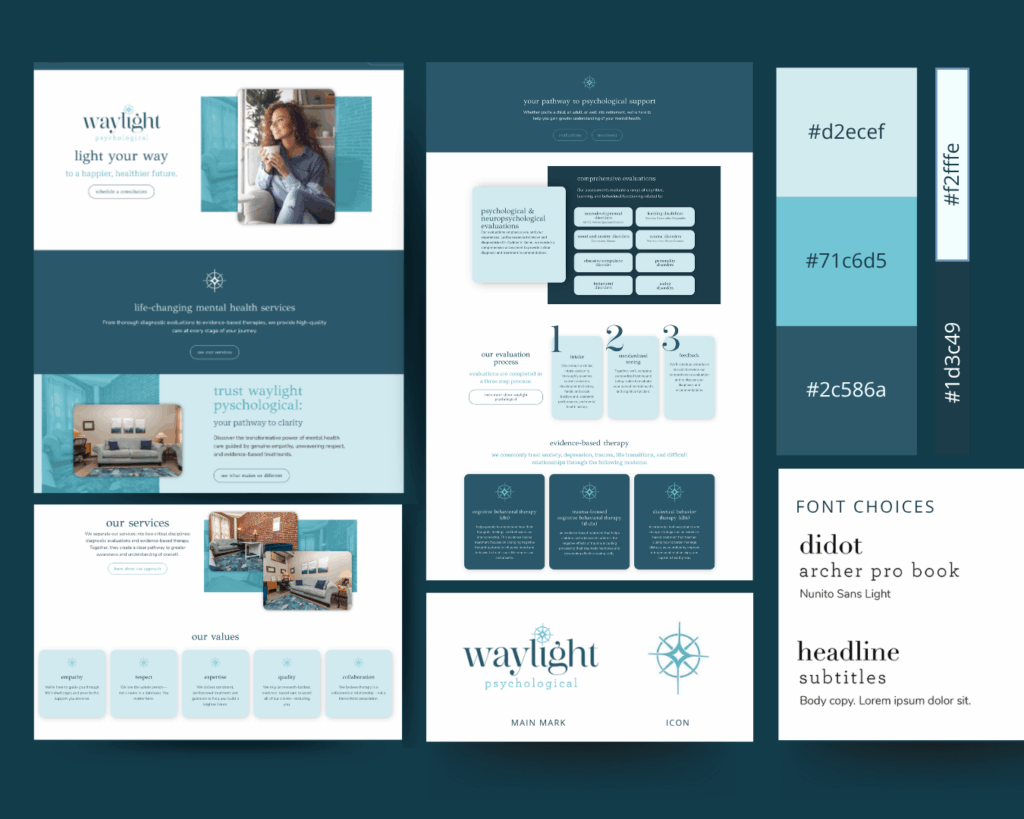
4. Nail Your Brand Guidelines and Designs
Your brand’s visual and written identity is critical to your long-term success. Hard-and-fast rules around your logo, copywriting tone, fonts, and colors offer strict guide rails to your creative pieces that spark consistency for years to come.
With that said, let’s start with what not to do:
- Don’t develop your logo in a simple online logo generator tool. (We’re looking at you, Wix!)
- Don’t prompt ChatGPT and accept the first logo it generates for you.
- Don’t hop on Fiverr and choose the cheapest artist you find.
Each of these is a shortcut that defies an important rule: Be thoughtful and intentional in your branding. You can’t shortcut your way to a great brand.
Related Reading: 3 Pros and Cons of ChatGPT In Content Marketing
Putting in the proper amount of time and technique helps you develop your brand’s:
- Font choices
- Color options
- Logo options
- Website design and user experience
- Social media posts and designs
- Copywriting tone
- And more
All of which can then blend seamlessly together to create a visual story your audience won’t forget.
Poetica Marketing Pro Tip: Great brands don’t happen overnight. Most new business owners are eager to jump right into sales and the day-to-day operations of the business—but doing the hard branding work first makes everything easier.
5. Know Your Partners, Sales Team, Ambassadors
To borrow a tired business line: Your network is your net worth. In other words, you’re only as impactful as the team you build around yourself.
That’s especially true during a brand launch, when momentum, reach, and consistency matter most. You don’t have to launch alone—and honestly, you shouldn’t.
As we said before, brand building shares many commonalities with relationship building. This is the part that looks beyond your audience, and into the valued relationships you can develop amongst your ideal partners and team members.
To maximize your reach, loop in:
Your Partners
Consider all the vendors, freelancers, suppliers, or fellow business owners you’ve collaborated with so far. These are people who may want to see you succeed—and who might be willing to share your launch on their platforms, offer joint promotions, or simply spread the word.
Examples include:
- Your web designer or marketing agency
- Retail partners who will stock your product
- Influencers or collaborators you’ve tested ideas with
If you’re still building these relationships, this is a perfect moment to ask: How can we grow together?
Your Sales Team
Even if it’s just one or two people, your sales team should be fully dialed in during the launch window. Arm them with:
- Social-ready graphics
- Talking points about your brand
- A schedule of promotions, emails, and updates
- Clear calls-to-action that reinforce your positioning
Remember that they’re not just selling—they’re stewards of your brand identity.
Poetica Marketing Pro Tip: Need a strategic boost to your sales strategy? Download a free copy of Boost: The Solopreneur & SMB’s Marketing & Sales Playbook—your roadmap to a streamlined, effective strategy that generates more leads, closes more deals, and increases revenue.
In these pages, you’ll learn how to:
- Boost your sales close rate by 10-20%
- Bridge the gap between marketing and sales for a seamless customer journey
- Create a lead generation system that never runs dry
- Overcome objections before they kill your sale
- Build a CRM-driven process that tracks and improves conversions
Your Brand Ambassadors
If you’ve already identified ambassadors, give them tools to do what they do best: Amplify your message.
Prepare:
- Pre-written captions (with some flexibility for tone)
- On-brand visuals (photos, product shots, behind-the-scenes)
- A launch hashtag (or two)
- A clear timeline of when to post, engage, and tag
Encourage interaction—not just posting. The algorithm rewards conversations, not just announcements. Treat your ambassadors like collaborators, not just a megaphone.
Related Reading: How to Develop A Content Strategy Plan For Your Small Business
6. Create A Schedule
You know what’s worse than a launch that falls flat? A launch that confuses your audience or overwhelms your team.
That’s why timing is everything. You need a clear, visible, tactical schedule that maps out every step of your rollout—from teaser to post-launch thank-yous.
Here’s what your brand launch schedule should include:
Social Media
What you should know about social media:
- What day and time each post goes live
- Who is posting it (you, your designer, your ambassadors?)
- What platform it goes on (Instagram, LinkedIn, TikTok?)
- Who’s tagged and what hashtags are used
- What the follow-up engagement looks like (Comments? Replies? Shares?)
Email Campaigns
Know the following about your email strategy:
- When each email is scheduled to send
- What segment(s) each email goes to
- What landing pages or actions you’re driving toward
Poetica Marketing Pro Tip: Don’t forget to time these around your social and PR pushes—everything should feel cohesive.
Website Content
For your website, you should note:
- When launch-related pages go live
- What blogs, landing pages, or updates support the launch
- What conversion elements are in place (CTAs, lead magnets, shop buttons)
Poetica Marketing Pro Tip: Have a “soft launch” checklist too. Test your links, forms, product inventory, and analytics before you go live. You only get one first impression—don’t let it break on page load.
Press/Live Activations
If you’re engaging with the press or hosting a live activation (like a launch party or an open house), know the following:
- When your event starts and ends
- What time your team should plan to set up and, later, tear down
- What your vendors require for their own business
- What your reporter and their photographer needs from you or your team
Related Reading: How to Build Your Marketing Budget
Brand Launch Strategy Case Study: Steel Rippers
Here’s a snapshot of how we assisted in the launch of Steel Rippers, a Pittsburgh-based motorcycle apparel brand that threw us a major hurdle: The founder had a critical medical emergency the day before the launch.
Marketing & Branding
Some of our strategies included:
1. Low-Cost Guerrilla Marketing
Because our overall marketing budget was somewhat limited, we looked for affordable and creative ways to reach their motorcycle-riding target audience.
Step one: We peppered well-known Pittsburgh biker hangouts with promotional posters, which included the overlook on the iconic Mt. Washington and outside prominent biker bars.
We also deployed eye-catching strategies on social media. In one post, we captured the Steel Rippers founder dropping a lit match into a trash can labeled “POSER GEAR”—an attack on cheap, inferior brands.
It was a hit in Steel Rippers’ own social media feeds, and it sparked lively conversations in local biker Facebook groups.
2. Social Media Strategy
Our social technique adopted a variety of tactics to amplify messaging and reach a much wider audience than Steel Rippers initial followers. Some of our techniques:
- We guided the founder’s small team of early brand ambassadors—a mix of “small” but enthusiastic riders and prominent bike photographers—and worked with them to develop a schedule for post collaborations on Instagram. We also employed a group chat to ensure all ambassadors engaged with each social media post immediately after publishing.
- We leveraged a modest promotion budget to coordinate ads on Facebook, Instagram, and Eventbrite, strategically boosting the announcement to the Steel Rippers target audience.
- We built a Facebook event page to drive additional interest and traffic to the Eventbrite registration page.
- We coordinated a schedule of collaboration posts with partnering vendors for the day-of event, including a classic boxing-inspiring poster featuring the partnering band (Fuse) and Steel Rippers.
3. PR & Publications
Immediately after picking an event date and nailing down the specifics, we added the launch to local and industry online event boards, such as:
- Pittsburgh Morning
- Hey Pittsburgh
- Positively Pittsburgh
- City Paper
- Twisted Road
- CycleFish
At the same time, we scored a feature in the Pittsburgh Post-Gazette, Pittsburgh’s largest newspaper, and we coordinated a takeover of the City Paper website and weekend email blast—garnering thousands and thousands of impressions in the process.
4. Email Collection and Coordination
We collected registrant email addresses through Eventbrite, then added them to the Steel Rippers Squarespace CRM. We then leveraged the Squarespace marketing suite to email custom reminders to all registered email addresses.
Note: We also collected nearly 50 additional email addresses from day-off registrations at the launch party, further building the Steel Rippers community!
5. Designs & Promotions
We were lucky; unlike many of the early brands we work with, Steel Rippers already had a strong logo and visual identity—which made it much easier for us to design a series of posters and banners for social media and the in-person event.
That said, we wanted to push the boundaries of the branding even further. As we began developing the campaign, we leveraged additional assets such as textured, torn paper, wheat-pasting effects, and black and white faded photography. All of which emphasized the gritty yet energizing appeal of the event.
Within our list of final design deliverables, we devoted special attention to:
- Standing signage near the registration table
- Branded wraps for the stage during the event
- Custom parking signs
- Custom beer bottles
- Custom graphics for social media, digital ads, and email strategy
As you can see, they looked excellent on the day of—and they immediately boosted the overall event quality while fostering an immersive experience.

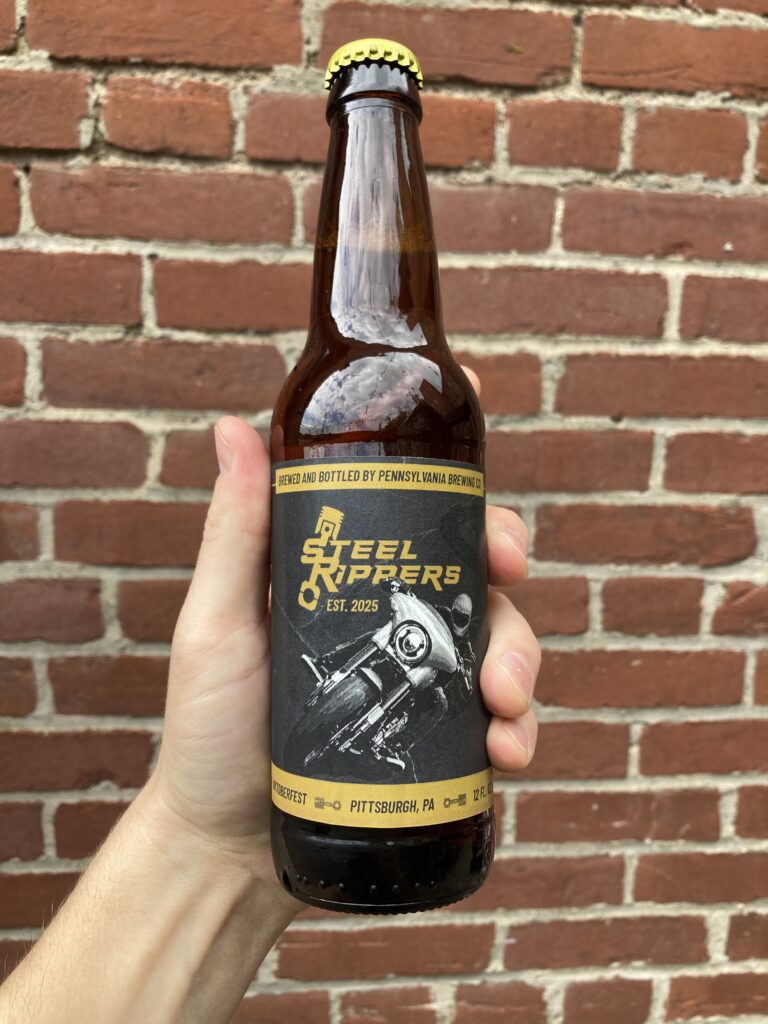
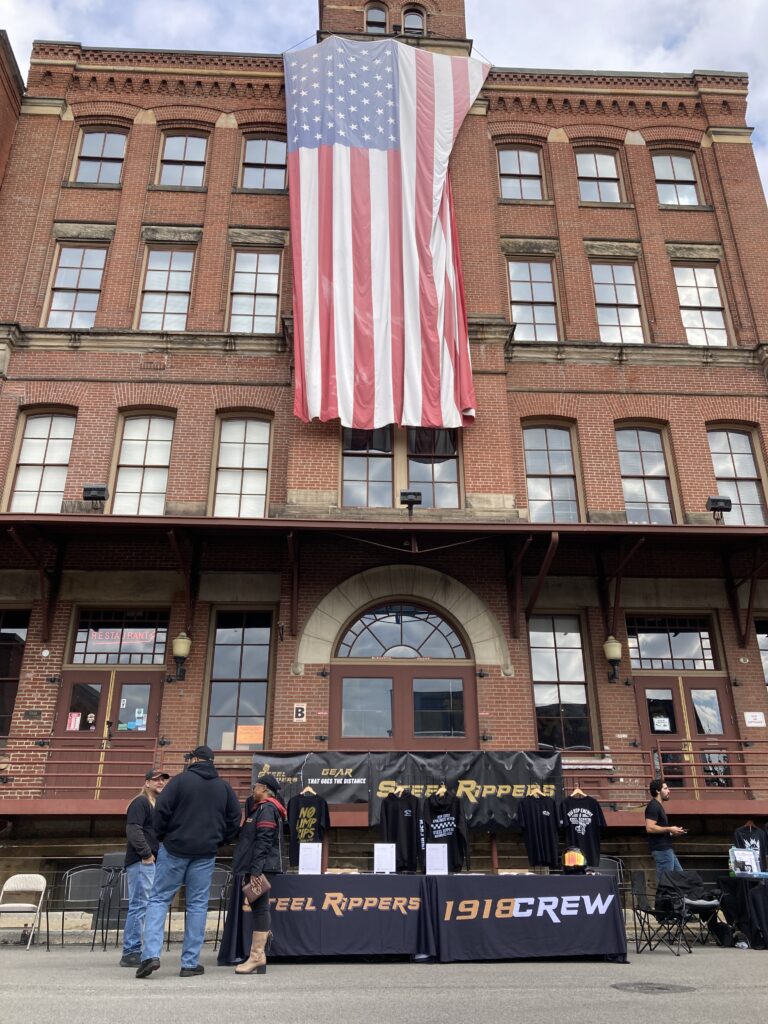

Planning & Coordination
We began planning and coordinating the moment our agreement was signed, and everything culminated into a smooth day-of. Our team:
- Assisted in picking perks and attractions, including the different access levels between VIP and general admission
- Reviewed multiple potential venues, finally settling on a brewery with a rustic setting to back the motorcycle aesthetic
- Developed multiple ground plans to optimize the use of space and maximize attendee enjoyment, ultimately finalizing the ground plan with a week to spare before the event
- Coordinated multiple vendors, including lighting/stage, venue, hired day-of workers, tattoo artist, cigar vendor, and others.
- Curated the food and drinks menu to provide an elevated experience for guests—especially the VIP attendees.
- Distributed walk-talkies and provided direction to a local police officer to maximize safety and communications.
- Established safe parking zones (complete with custom signage) for the dozens of motorcycles that arrived throughout the event.
After the event, we continued to monitor fan feedback on social media, and we noted comments such as:
- “Thank you #steelrippers for throwing an awesome event yesterday. I met some cool people and I finally got to check out the offerings from #whiteknucklerbrand in person.”
- “@steelrippers launch party was amazing!”
- “@steelrippers launch party was everything I didn’t expect and more that I didn’t know I wanted in a launch event.”
Related Reading: How to Plan A Corporate Event: 6 Questions to Make Your Event Matter
Brand Launch Results
Thanks to our efforts, the brand:
- Achieved ~200,000 impressions across Facebook and Instagram (and more through other, third-party tactics)
- Attained a 1,600% increase in average monthly site traffic over the course of the campaign
- Exceeded its launch party registrations goal by 59%
- Received prominent exposure in the Pittsburgh Post-Gazette and City Paper
Our work also won us this wonderful client review:
“Poetica Marketing was an incredible partner for my Underground Rally and Launch Party at Penn Brewery. They helped me market the event, secure earned press in the Pittsburgh Post-Gazette, and handled everything from planning and organization to day-of logistics and live social media coverage. They’re genuinely kind, knowledgeable people who bring both professionalism and creativity to the table. I’m grateful for all their hard work and was fortunate to have them in my corner. Highly recommend!“
Find Your Brand Strategy Partner
Launching a brand isn’t just about going live—it’s about going loud, clear, and strategic. Whether you’re a startup founder preparing your first product launch, or a growing company ready to reposition your brand, you need more than a logo and a launch party. You need a thoughtful, scalable brand launch strategy that delivers visibility, credibility, and results.
That’s where we come in.
At Poetica Marketing, we specialize in building brand identities and go-to-market strategies that work in the real world—from scrappy, guerrilla-style tactics to polished, multi-channel rollouts. We’re not just designers and copywriters; we’re strategic partners who care about your business outcomes, your customer experience, and your long-term reputation.
Want a brand launch that doesn’t just look good—but also performs well?
Contact us today to start building your brand launch strategy with our team. Or explore our portfolio and case studies to see how we’ve helped other bold brands make their mark.
Frequently Asked Questions About Brand Launch Strategy
What is a brand launch strategy?
A brand launch strategy is a coordinated plan for introducing your brand to the public. It typically includes messaging, design, marketing, PR, social media, events, and other tactics to generate awareness and engagement from your target audience.
How long does a brand launch strategy take?
Ideally, planning should begin 60–90 days before your go-live date—at a minimum. This gives you time to refine your messaging, create marketing materials, build hype, and coordinate all moving parts. Giving yourself more time will make your life much easier—and any supporting agencies or partners you bring along will be immensely grateful.
Do I need a full marketing budget to launch my brand?
Not necessarily. Many brands start with lean, high-impact tactics—like organic social campaigns, targeted partnerships, or strategic launch events—before scaling their efforts over time. A budget of $50,000+ to start can be great, but we’ve seen strong campaigns run on much, much smaller budgets of a few thousand dollars.
What types of businesses benefit from a brand launch strategy?
All of them. Whether you’re launching a product, a service, or a full company, a brand launch strategy helps you make the right first impression with your target audience. It’s like the old proverb says: You only get one chance to make a first impression. Make yours count.
Do I need a full website before launching?
Not necessarily. Sometimes a landing page is enough to start testing your message and building early buzz. However, if you plan to ever have a website to promote your business or assist in sales, you should have at least a simple site up and running as part of your go-to-market strategy plan.
Why is a good brand launch so important?
A strong brand launch is the starting point of your company. Done well, it can establish an engaged audience that enthusiastically watches and promotes your growth for years to come. Done poorly, however, you can create a difficult uphill battle as you work to establish a meaningful revenue stream and a foothold in your industry.

